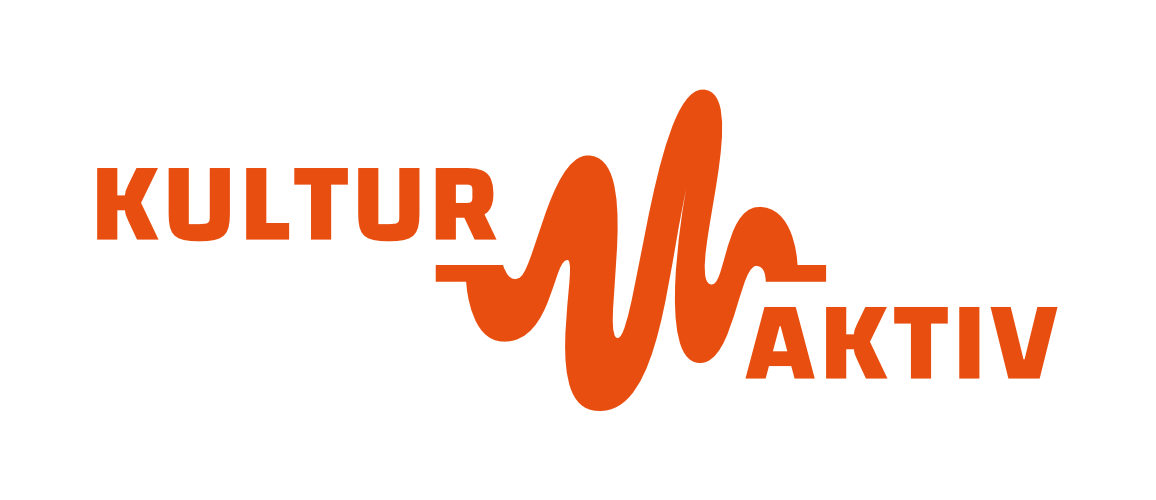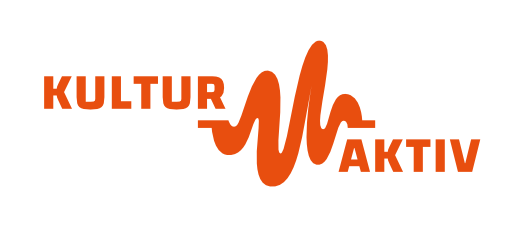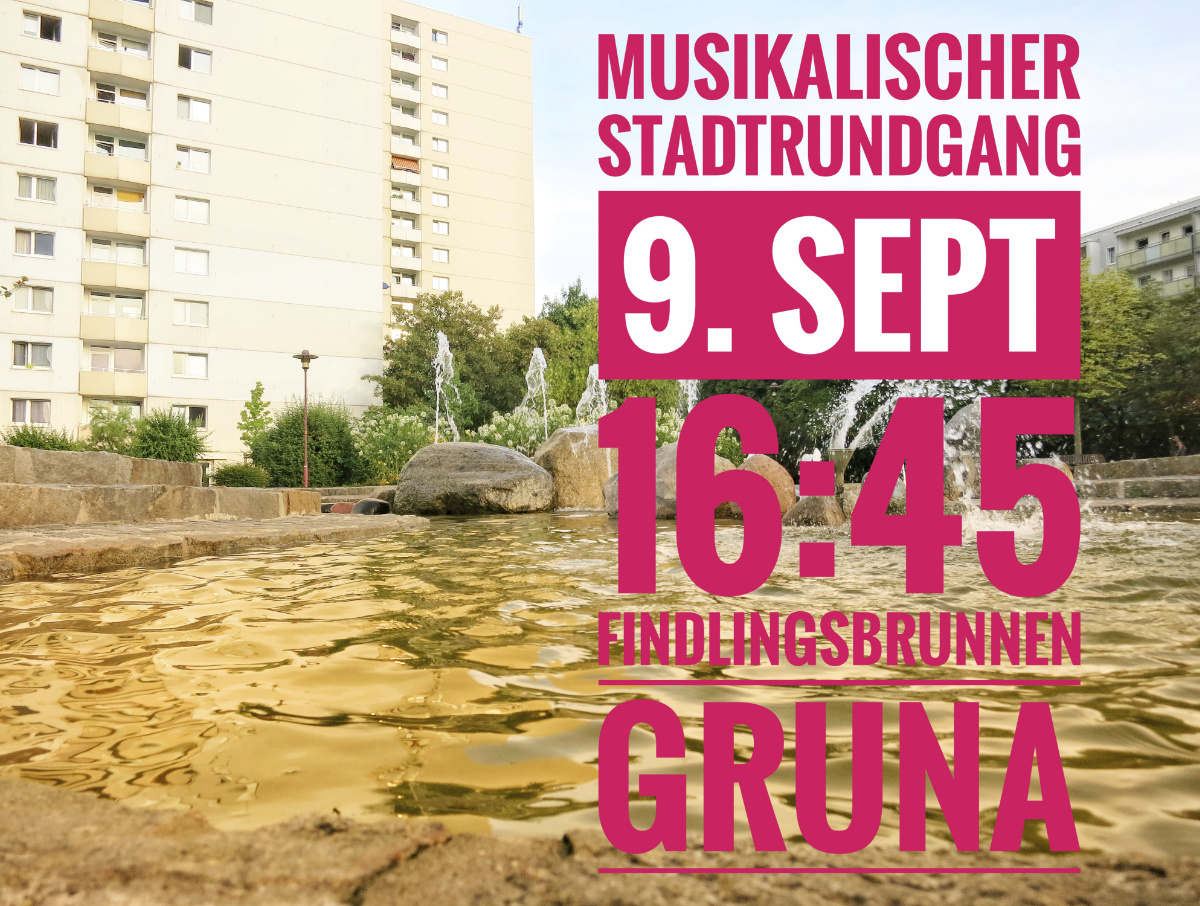On 09 September, the Dresdner Nachbarschaften went on a discovery tour in Gruna
text: Uta Rolland · photos: Yvonn Spauschus
The erratic boulder fountain is located in the middle of high-rises and semi-refurbished low-rise buildings in the heart of Gruna. The large round stones and the asymmetrical layout offer a welcome contrast to the historic GDR buildings around the square. The murmur of the water mixes with the sounds of an accordion and the screeching of a little girl who uses a puddle on the sloping concrete slabs to splash around. The musician plays for a group of people sitting on folding chairs and enjoying the enchanted atmosphere. The accordionist Steffen is from here and is a musical veteran who has played in the neighbourhood many times, also as part of the legendary fountain festivals that existed until Corona. Today he was there as part of the Neighbourhood Days and was recognised and approached by some residents.
Originally, the square, Altgruna, had a village character, as Hannah reports. The young woman from the association In Gruna leben e.V. will guide us today. She tells us that the development was built in the 1980s. Jan, a young man and participant in today’s tour, used to live in one of the high-rise buildings, on the 15th floor. He can’t tell us much about the neighbourhood, though. It was rather anonymous living in the building, which, despite all the planning, is said to have been built more by chance than anything else, as there were still slabs left over from another building site. There is little sign of a lively district centre here – the unrenovated department store on the side of the square makes an abandoned impression, and the shops in the boulevard area, apart from Norma, hardly seem to be visited. On the way to Rothermundpark, the sandstone sculptures “fighting billy goats” by the Dresden artist Wolfram Hesse, created in 1986, catch the eye. It becomes clear that Jan is well acquainted with art on buildings in GDR times.
Next to the adjacent low-rise building, a medical centre, Hannah explains how her association came into being and how a citizen participation process developed that is now exemplary for the entire city: the urban developmentally neglected area of Gruna is to be upgraded with urban development funding. To this end, the city initiated a competition in 2017 involving various planning offices. However, the proposed solutions presented to the public did not meet with the approval of the residents, partly because the demolition of the medical centre was considered. In a new attempt, city planners and residents came together to find solutions for revitalising and redesigning the district, which is to become livelier, cleaner and more beautiful. At the same time, the familiar is to be preserved. In 2020 and 2021, citizen participation workshops, an online survey of Gruna residents and future workshops were used to create approaches in which the city’s plans came together with the interests of the residents in a process of mutual trust. The association In Gruna leben e.V. supported the implementation with several thematic district tours; it has become a meeting point and a mouthpiece for the actors in the district and a contact for urban development concerns on the part of the city.

Things are also supposed to happen in Rothermundpark, as Hannah tells us when we cross Rosenbergstraße. At least there is something going on here – under the green roof of leaves there is a buzz of voices of families, children and young people using the playground and the skate park.
The path leads us along the Landgraben. Hannah is happy to see that it is flowing. She reports that the ditch and the small bridge we pass are a popular meeting place for young people in the warm months.
Then we come to the Gartenheimsiedlung area – and are amazed. Behind spacious gardens are two-storey apartment buildings with loggias and mullioned windows. You can see that every flat has its own garden, and yet it all seems like one big enclosed garden landscape with beautiful, individual details. Is this any way to live in Dresden, close to the centre and the Großer Garten? Yes, says Hannah, but a waiting period of ten years should already be planned. The houses we are walking along at the back belong to the Gartenheimsiedlung, which was built in the 1920s as a large housing estate by the Gartenheim building association and is now a listed building. Partially destroyed during the war, it was essentially rebuilt and increasingly threatened by decay in the 1990s. By 2003, the building stock had been renovated and now belongs to the housing cooperative “Aufbau”, currently the largest housing cooperative in Dresden. Still amazed, we turn off at Grabenwinkel and get an impression of the character of the estate, where every structural design element fits harmoniously into the overall picture and the greenery of the gardens is continued in the outdoor areas of the streets and squares.
It is beautiful here in Gruna, the “place in the green meadow” – a district with a population that likes to be at home here, works together to develop and strengthen their place of residence and has an eye on the future, which is about strengthening neighbourly togetherness and actively influencing the further development of the district.
One thing is certain: there is nothing here at the END.
Grunaer Findlingsbrunnen
Dresdner Nachbarschaften
Damals, Heute, Morgen / Zuhören, Erinnern und Gestalten
In our storytelling cafés and discussion groups, district tours and workshops, we want to encourage you to tell stories and develop visions.
Period
05-12.2022
Project coordination
Yvonn Spauschus (project management)
Anne Ibelings · Moussa Mbarek · Nadine Wölk (workshop leader)
Uta Rolland · Rosa Brockelt · Rosa Hauch · Falk Goernert (moderation and documentation)
Cooperation partners
JugendKunstschule Dresden · Omse e.V. · Löbtop e.V. · Quartiersmanagement Prohlis, Johannstadt and Gorbitz · Sigus e.V. · In Gruna leben e.V. · UFER-Projekte Dresden e.V.
Supported by

The project is funded by the House of Resources Dresden+



